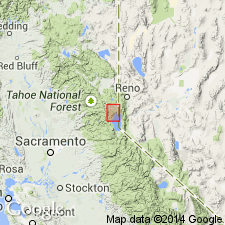
- Usage in publication:
-
- Hirschdale olivine latite member (informal)
- Modifications:
-
- Original reference
- Dominant lithology:
-
- Latite
- AAPG geologic province:
-
- Sierra Nevada province
Summary:
Pg. 1453-1464. Hirschdale olivine latite member of Lousetown Formation. Stratigraphic and structural evidence demonstrate that Hirschdale olivine latite is youngest of Lousetown flows in Truckee area. It is younger than Polaris and Bald Mountain members (both new) because Prosser Creek alluvium overlies both of them. Also younger than Dry Lake flows (new) for fault truncates latter flows on west and does not offset Hirschdale farther north. Potassium-argon age determination of this flow gives 1.3 [Ma]. At least 20 flows recognized in area. Nine flows (or groups of flows) are named and given informal member status in Lousetown Formation. Age is early Pleistocene.
Named from occurrence near settlement of Hirschdale, [in sec. 34, T. 18 N., R. 17 E., Truckee 15-min quadrangle], Truckee area, north of Lake Tahoe, [Nevada Co., northeastern CA].
Source: US geologic names lexicon (USGS Bull. 1350, p. 334); supplemental information from GNU records (USGS DDS-6; Menlo GNULEX).
For more information, please contact Nancy Stamm, Geologic Names Committee Secretary.
Asterisk (*) indicates published by U.S. Geological Survey authors.
"No current usage" (†) implies that a name has been abandoned or has fallen into disuse. Former usage and, if known, replacement name given in parentheses ( ).
Slash (/) indicates name conflicts with nomenclatural guidelines (CSN, 1933; ACSN, 1961, 1970; NACSN, 1983, 2005, 2021). May be explained within brackets ([ ]).

